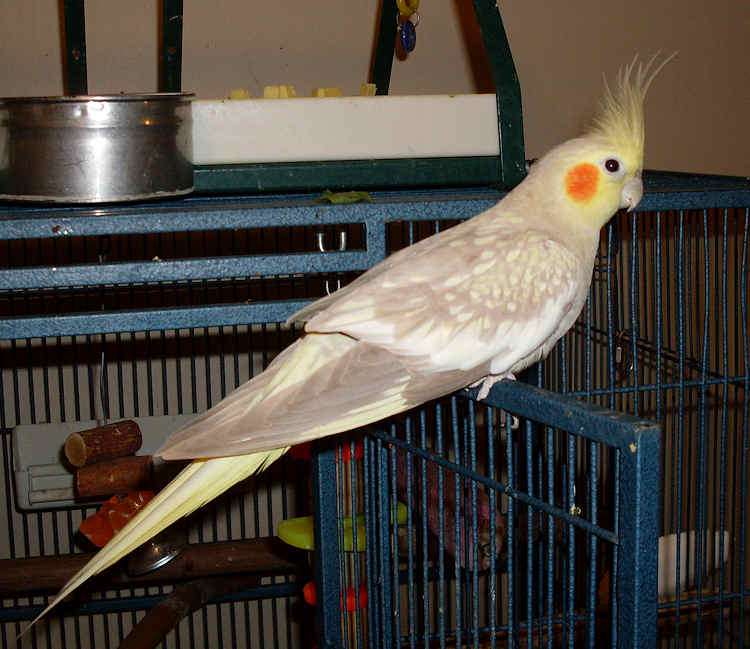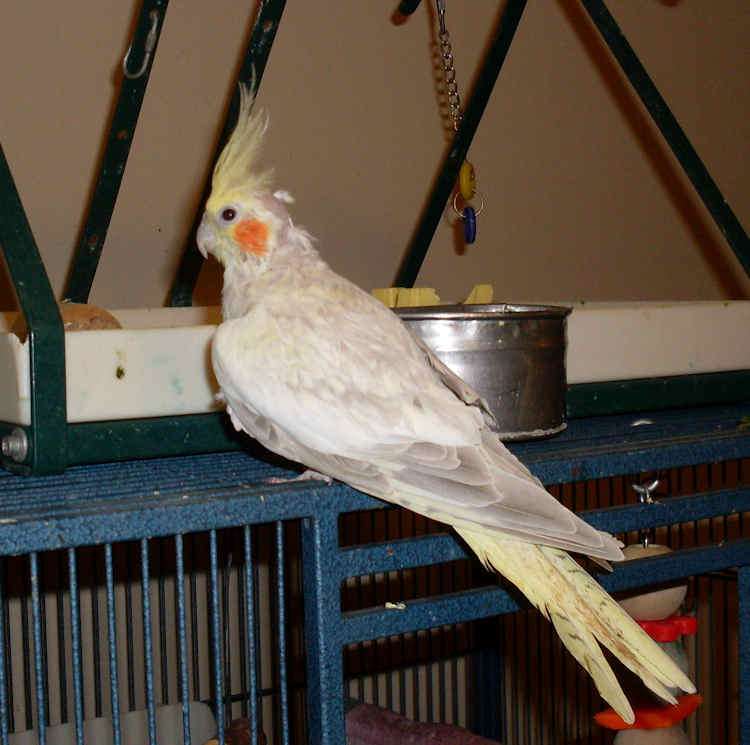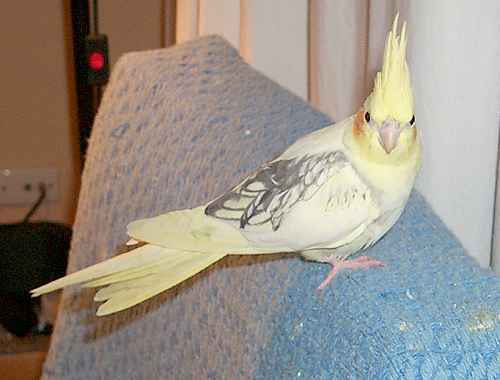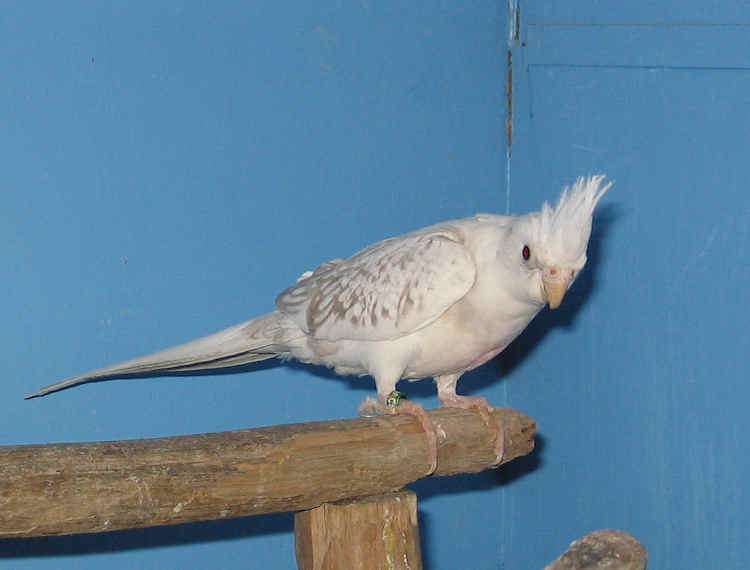|
|
Post by greyeagle1 on Feb 14, 2013 15:04:38 GMT 10
Can someone show me a picture of a pearled cockatiel? I know that they are somewhat variegated in color, but are they yellow and grey variegated or white and grey variegated? Do they come in both combinations, or am I thinking of the pied cockatiel?
|
|
|
|
Post by avinet on Feb 14, 2013 21:49:44 GMT 10
The Pearl mutation can be found in all colour variations of cockatiels, and I am including some photos below. If it is in the normal grey and pale yellow colour then it is just a pearl cockatiel. If the body colour is cinnamon rather than grey then it is a cinnamon pearl cockatiel. Similarly if a platinum then it is a platinum pearl and if the body colour is white-face (all yellow lost form the body colour) then it is a white-face pearl. And white faces also come in cinnamon and platinum colours as well. You can even have a lutino pearl where the pearl effect is visually subdued - just a pale yellow speckling on the pale cream body colour Pearl can also be combined with pied to give a pearl-pied, in all the different colours. In addition with pearl in cockatiels only the adult females can appear as pearl. A young male can look pearl but as it matures towards 12 months the pearling is almost completely lost with only a hint remaining to indicate its genetic makeup anyway to the photos cheers, Mike  A normal grey pearl hen - called Pearl Girl and sadly no longer with us. A normal grey pearl hen - called Pearl Girl and sadly no longer with us. Taffy, a 21 year old cinnamon pearl photo'd this evening. Taffy, a 21 year old cinnamon pearl photo'd this evening.  Lacey, also 21 years old and photo'd this evening - a platinum pearl Lacey, also 21 years old and photo'd this evening - a platinum pearl
 Jacki - a pearl-pied who died a couple of years ago at 17 years old. Jacki - a pearl-pied who died a couple of years ago at 17 years old. A cinnamon white-face pearl pied, photo'd in our old shop. A cinnamon white-face pearl pied, photo'd in our old shop. Taken in our shop to illustrate the loss of pearl markings in a male pearl cockatiel. The closest bird is a full pearl as a male would look when 3 or 4 months old, while the middle bird is a male who has partially lost his pearl markings - he will be around 9 or 10 months old, and the furthest bird is an adult male with only a trace of the pearl left - aged at least 12 months Taken in our shop to illustrate the loss of pearl markings in a male pearl cockatiel. The closest bird is a full pearl as a male would look when 3 or 4 months old, while the middle bird is a male who has partially lost his pearl markings - he will be around 9 or 10 months old, and the furthest bird is an adult male with only a trace of the pearl left - aged at least 12 months |
|
|
|
Post by greyeagle1 on Feb 15, 2013 5:09:15 GMT 10
Is that a platinum pearl in the photo you showed me in the thread, "Is this normal during a molt?" Also, do the natural solid grey cockatiels have a color change (get darker or lighter) once they are adults?
|
|
|
|
Post by avinet on Feb 15, 2013 9:22:45 GMT 10
Is that a platinum pearl in the photo you showed me in the thread, "Is this normal during a molt?" Also, do the natural solid grey cockatiels have a color change (get darker or lighter) once they are adults? Yes - it is Lacey, the Platinum pearl in the Pearl Cockatiel thread, also photo'd last night. Grey cockatiels will often get darker with maturity - often a young grey around 8-10 months will have a mix of lighter and darker feathers on their body as the new feathers are coming through. cheers, Mike |
|
|
|
Post by greyeagle1 on Feb 17, 2013 13:29:16 GMT 10
Just seen this website for an Australian cockatiel society and saw some unusual colored cockatiels pictured on the home page that I am curious about. I wonder if these are a newly developed variety? I will try and paste the link here. They are a rich dark solid grey, except the head, which is white. Hmmm.... www.cockatiel.org.au/ |
|
|
|
Post by avinet on Feb 17, 2013 16:18:17 GMT 10
The bir dis a White-face normal - a mutation where the bird's ability to produce yellow and orange colours is lost so the areas that would have had a yellowish colour, or the orange cheek patch, become white. It first appeared in Australia in the very early 1990's and at that time was very expensive - over $1000 a bird. These days they should be no more expensive than other cockatiel mutation colours.
In the final years of our shop (closed 2010) we sold all hand raised cockatiels, no matter what the colour, for the same price - $100.
cheers,
Mike
|
|
|
|
Post by greyeagle1 on Feb 18, 2013 2:25:04 GMT 10
Are the grey white-faced ones rare?
|
|
|
|
Post by avinet on Feb 18, 2013 20:38:03 GMT 10
Are the grey white-faced ones rare? No, these days they are common, at least in SE Queensland. As I said in my earlier reply we were selling them at the same price as the normal greys for hand raised babies, and price is a reflection of supply and demand. cheers, Mike |
|
|
|
Post by greyeagle1 on Feb 20, 2013 11:30:04 GMT 10
Interesting, because I have not seen one in a single pet shop over here. They seem to sell more of the other varieties.
|
|
|
|
Post by avinet on Feb 20, 2013 21:08:28 GMT 10
The White face Cockatiel first appeared in Holland in 1969, and was first imported into the US in 1984 by Dale Thompson, a well known Californian breeder. I had a look at a US site for advertising Cockatiels - www.petclassifieds.us/c/1106/Cockatiels.html - and there are a fair number for sale there - at prices not much different from other colours. The lack of them in your local pet stores may just reflect what the local breeders are producing. cheers, Mike |
|
|
|
Post by vampirebat on Mar 6, 2013 18:00:38 GMT 10
They seem really messed up.
|
|